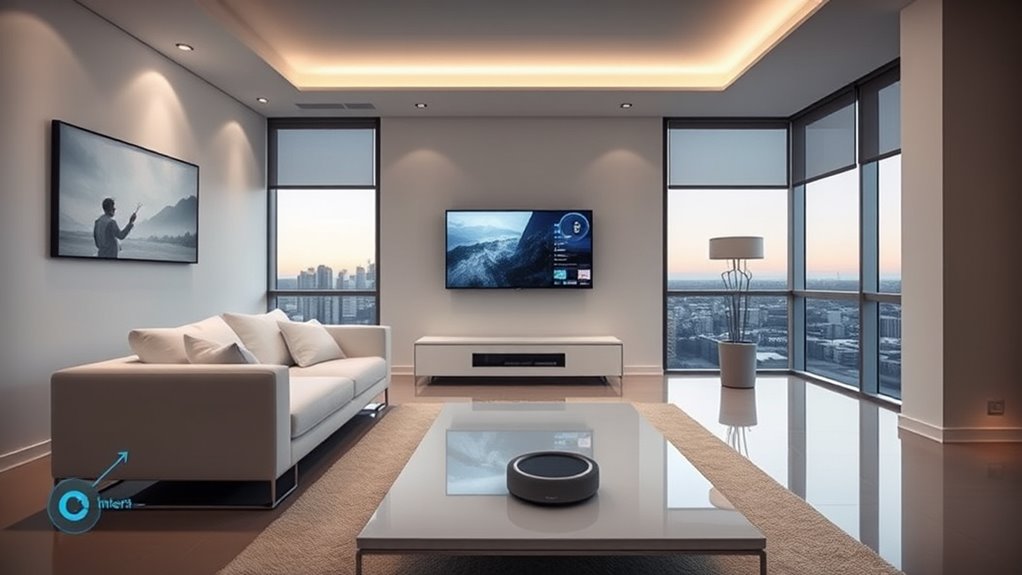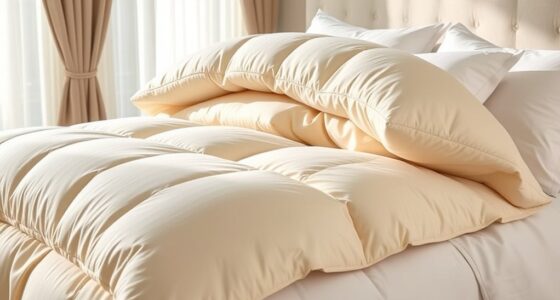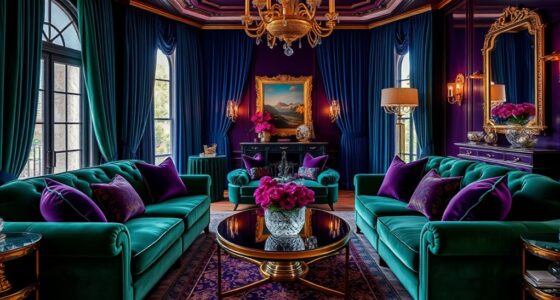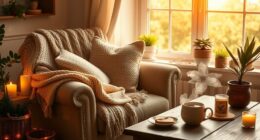In the past decade, modern home design has centered on sustainability, smart technology, and open, light-filled spaces. You see more eco-friendly materials like reclaimed wood, combined with energy-efficient systems and automation for convenience and savings. Flexible layouts support work, relaxation, and entertainment. Wellness features such as biophilic design, natural light, and greenery are everywhere. If you keep exploring, you’ll discover how these trends continue to shape innovative, sustainable, and comfortable living environments.
Key Takeaways
- The 2010s saw widespread adoption of open floor plans, large glass walls, and indoor-outdoor integration.
- Increasing emphasis on eco-friendly materials, energy efficiency, and sustainable certifications like LEED became mainstream.
- Smart home technology and automation systems revolutionized how homes are controlled and personalized.
- Biophilic design elements, natural materials, and greenery became central to enhancing wellness and aesthetic appeal.
- Advances in construction techniques and innovative materials enabled brighter, more adaptable, and sustainable living spaces.
The Rise of Sustainable Materials and Eco-Friendly Practices

The 21st century has marked a pivotal shift toward sustainability in home design, with more homeowners and builders choosing eco-friendly materials and practices. You’ll notice a rise in sustainable materials like reclaimed wood, bamboo, cork, and recycled metals, which reduce environmental impact. Eco-friendly practices, such as energy-efficient insulation, solar panels, and low-VOC paints, have become standard, promoting healthier indoor environments. Certifications like LEED and WELL encourage the use of environmentally responsible materials and green building techniques. Advances in biodegradable and non-toxic finishes help minimize toxic emissions and waste. Additionally, the integration of natural elements inspired by farmhouse bedroom decor emphasizes the importance of authentic, sustainable interiors. This trend is driven by growing awareness of environmental issues and your desire for healthier living spaces. By prioritizing renewable resources and recycled materials, you contribute to a more sustainable, eco-conscious future. Incorporating eco-friendly materials into design not only benefits the environment but also enhances indoor air quality and overall well-being. The adoption of green building techniques further supports energy conservation and resource efficiency, making sustainable design more practical and impactful. Furthermore, innovations in sustainable manufacturing processes are making eco-friendly options more accessible and affordable for homeowners.
The Integration of Smart Technology and Home Automation

As smart technology becomes more integrated into our homes, automation has transformed the way you interact with your living space. IoT devices and home automation systems connect appliances, lighting, security, and climate control, making daily routines seamless. Voice-activated assistants like Alexa or Google Home allow you to control devices with simple commands. Smart thermostats learn your preferences and optimize energy use, reducing costs by up to 20%. Smart security devices enable remote monitoring and management, enhancing safety. Interconnected appliances create a cohesive, efficient environment. Additionally, integrating heat pump systems with smart technology can further improve energy efficiency and indoor comfort. As the adoption of AI in home systems continues to grow, homeowners can benefit from more intuitive and adaptive environments. Embracing home automation trends ensures your living space stays ahead in convenience and sustainability. Furthermore, advances in projector technology allow for immersive entertainment experiences that seamlessly integrate with smart home setups, elevating your home cinema capabilities. Incorporating energy-saving features into your smart home can significantly reduce environmental impact and operational costs.
The Shift Toward Flexible, Multi-Use Spaces

Smart technology has made it easier to adapt your living space to multiple needs, paving the way for flexible, multi-use rooms. Open floor plans revolutionized modern homes by creating versatile spaces where living, dining, and work areas coexist seamlessly. Multi-use rooms now serve as multifunctional environments, accommodating remote work, family activities, or relaxation. Flexible furniture like fold-away beds and modular sofas boosts adaptability, allowing you to reconfigure spaces effortlessly. Design trends lean toward neutral palettes with bold accents, making it simple to switch between different uses and moods. Modern homes increasingly feature dedicated zones for work, fitness, and leisure, emphasizing adaptable design. Resources and tools such as smart home systems further enhance the functionality of these versatile spaces, allowing for seamless control and customization. Incorporating sustainable materials can also contribute to a more adaptable and eco-friendly living environment. To maximize interior design efficiency, careful planning ensures these spaces meet your evolving needs. As these spaces evolve, integrating adaptive design principles ensures they remain functional and stylish for years to come. These versatile spaces foster personalized living that adjusts to your lifestyle, blending functionality with style seamlessly.
Emphasis on Wellness and Biophilic Design Elements

In recent years, homeowners have increasingly prioritized wellness and biophilic design to create healthier, more harmonious living spaces. This approach emphasizes natural elements like plants, water features, and organic textiles to boost mental well-being and reduce stress. Large windows and glass walls enhance natural light and strengthen the indoor-outdoor connection, promoting home wellness. Sustainable materials such as reclaimed wood and stone foster a sense of harmony with nature while supporting eco-conscious living. Improving air quality through air purification systems and non-toxic materials is a key focus of wellness-centered interior design trends. Incorporating natural lighting solutions not only enhances the aesthetic appeal but also supports circadian rhythms and overall health. Additionally, integrating air quality improvement devices can significantly enhance indoor environments by reducing pollutants and allergens. For those seeking to incorporate more greenery, indoor plant care techniques are essential to ensure vibrant, healthy plants that contribute to a calming atmosphere. Understanding aura and energy dynamics can further personalize your space by aligning it with your unique emotional and spiritual needs. Developing an awareness of energy flow within your home can help optimize its positive effects and create a more balanced environment. By integrating biophilic elements, your home becomes a sanctuary that nurtures health, creativity, and productivity, aligning modern design with the fundamental human need for nature and natural light.
The Continued Popularity of Open Floor Plans and Natural Light

Open floor plans continue to dominate modern home design, with over 80% of new constructions featuring integrated living, dining, and kitchen areas. Large windows and glass walls maximize natural light, creating bright, inviting spaces that reduce reliance on artificial lighting. These spacious layouts enhance indoor-outdoor connection, aligning with biophilic design principles that boost well-being. Advances in construction technology make building expansive, light-filled open spaces more accessible and cost-effective. Creativity can be cultivated by anyone, regardless of skill level. This trend also elevates home value, as open floor plans sell faster and for higher prices. To illustrate, consider the following:
| Feature | Benefit |
|---|---|
| Large Windows & Glass Walls | Increased natural light and indoor-outdoor flow |
| Spacious Layouts | Enhanced comfort and flexibility |
| Construction Tech | Efficient, cost-effective open space creation |
This blend keeps modern homes bright, functional, and highly desirable. The use of innovative construction techniques continues to facilitate the realization of these open, light-filled designs, making them increasingly common in new builds. Additionally, the integration of energy-efficient materials supports sustainable living while maintaining aesthetic appeal. Furthermore, incorporating self watering plant pots into interior design can enhance indoor air quality and aesthetic appeal, complementing open floor plans and natural light through lush, well-maintained greenery.
Frequently Asked Questions
How Do Sustainable Materials Impact Long-Term Home Maintenance Costs?
Sustainable materials can considerably reduce your long-term home maintenance costs. They’re often more durable, resist pests, and withstand weather better, meaning fewer repairs and replacements over time. Plus, many eco-friendly options are low-maintenance, saving you time and effort. Though they might cost more initially, their longevity and resilience often lead to savings in the long run, making your home more cost-effective and environmentally friendly.
What Are the Best Smart Technologies for Energy Efficiency?
Imagine installing a smart thermostat like Nest, which learns your schedule and adjusts temperatures accordingly. You’ll save energy by avoiding unnecessary heating or cooling. These devices optimize your home’s energy use, reducing costs over time. By integrating smart technology like motion sensors and energy monitors, you actively manage consumption, making your home more efficient and environmentally friendly. This proactive approach guarantees comfort while cutting down on waste.
How Can Multi-Use Spaces Be Designed for Small Homes?
You can design multi-use spaces in small homes by incorporating flexible furniture like fold-away beds and tables, which save space when not in use. Use dividers or open shelving to create distinct zones without sacrificing openness. Opt for light colors and mirrors to make the area feel larger. Prioritize storage solutions that maximize vertical space, and choose multi-functional items that serve more than one purpose to keep the space versatile and functional.
What Are Key Biophilic Design Elements for Indoor Environments?
You should incorporate natural elements like plants, which improve air quality and add visual interest. Use large windows or skylights to bring in plenty of natural light, creating a connection with the outdoors. Incorporate natural materials such as wood and stone to add warmth and texture. Including water features or green walls can also enhance the sense of tranquility. These elements foster well-being and make your indoor space feel more alive.
How Do Open Floor Plans Influence Privacy and Noise Control?
Open floor plans create a spacious, connected feel inside your home, but they can challenge your privacy and noise control. You might find it harder to find quiet spaces or keep conversations private. To fix this, you can add strategic furniture, rugs, or partitions to absorb sound and create designated zones. These solutions help you enjoy the openness without sacrificing privacy or tranquility in your living environment.
Conclusion
Over the past decade, your home has become more sustainable, tech-savvy, and wellness-focused. Did you know that 78% of homeowners now prioritize eco-friendly materials? As you embrace smart technology and flexible spaces, you create a healthier, more adaptable environment. This shift isn’t just a trend—it’s shaping the future of modern living. So, get ready to design a space that’s not only stylish but also sustainable and personalized to your needs.









